You are hearing the difference between direct and reflected sound. Few speakers try to make them the same.the most disturbing part is when i turn my head, when i move my head to look to the right and the to the left, the far ear hears a very muted sound compared to my nearest ear, to the speakers that is, this difference drives me crazy, this sounds very unnatural,
The ones that do include planars (i.e. Magnepan) and box speakers with rear-firing tweeters and (possibly) midranges.
My Maggies sound the same regardless of whether I am facing towards or away from them.
Ed
I have "Master Handbook of Acoustic" by F. Alton Everest. I have the 4th edition. There is a 5th now. Recommended reading!
In it, page 496 starting at last paragraph. "Comb filtering can be controlled by using absorption, which removes sound energy from the room. or diffusion, which distributes the reflection over time without absorption. Both approaches are valid and produce different psychoacoustical reactions. Using absorption to reduce the effect of specular reflection will produce pinpoint spatial phantom images. On the on the hand, diffusion will produce sonic images with more spaciousness. The degree of this can be controlled"
In it, page 496 starting at last paragraph. "Comb filtering can be controlled by using absorption, which removes sound energy from the room. or diffusion, which distributes the reflection over time without absorption. Both approaches are valid and produce different psychoacoustical reactions. Using absorption to reduce the effect of specular reflection will produce pinpoint spatial phantom images. On the on the hand, diffusion will produce sonic images with more spaciousness. The degree of this can be controlled"
This is actually a pretty reasonable request, at least on the surface.i really would like to do my room acoustics a little more scientifically, [are] there any useful simple guides and rules how to think when setting up a 2 channel system regarding time windows for absorption and reflections and angles of incoming sounds?
There are ways to calculate surface area needed to get the needed amount of added absorption in the room to reach a reasonable RT30 response plot (i.e., RT30 vs. frequency that you get with something like a REW measurement), but everything I've seen is related to "the diffuse zone of the room"--far away from the loudspeaker end of the room. What this means is that the absorption is not in the near field of the loudspeakers (i.e., less than 2 wavelengths of sound at or above the frequency of interest). This doesn't help with the near field.
Generally, the picture is more murky when you consider the directivity of your loudspeakers vs. frequency (and where you've chosen to put them in relation to the room's walls, floor and ceiling). For any direct radiating loudspeakers, generally, they don't do a very good job of controlling their polars below ~800-1500 Hz--and perhaps higher. For corner horn loudspeakers, they may control their polars all the way down to the room's Schroeder frequency (about 100-200 Hz for medium-damped or lightly damped rooms). So with these type of loudspeakers, nearfield absorption/diffusion is much less of a concern and is easy to achieve with perhaps 12 ft^2 of absorption on the side walls. It may take 6 times that amount of nearfield absorption on the surrounding walls for a loudspeaker that doesn't control its polars below 1-1.5 kHz.
Note that Flaesh above posted a plot of desired room treatment type vs. frequency--absorption for low frequencies and diffusion for high frequencies. Unfortunately, once you place absorption in-room for low frequencies, generally, the absorbers usually get more and more effective as the frequency rises. So, again, there are complications.
So you can, fairly straightforwardly, calculate the amount of surface area absorption needed (away from the loudspeakers--at least 2 wavelengths at the lowest frequency you want to acoustically treat). But the nearfield absorption/diffusion needed is not so straightforward--because of the loudspeaker directivity issue described above. It's pretty much cut-and-try until you reach something that's a good compromise, I've found. This is not easy to calculate because of geometries and loudspeaker directivities, as well as absorption material effectiveness vs. frequency and by thickness of the absorption material.
In general, the more broad-band diffusion you add the better the resulting sound in-room, but the limit of what your ears want is usually far in excess of what people want to spend on diffusion panels and what it looks like when you're done.
Room modes are a direct function of the dimensions of the room, so there's not much you can actually do with those--except move the listening position(s) around to avoid strong modes.
Hope some of this leads to something useful.
Chris
This is a really interesting topic.
It just struck me that bad room acoustics has a lot in common with depression. There's plenty of knowledge out and around about the how's and why's, but when it gets hands-on, there are no instructions on how and where to start. I am suffering both at the same time, which doesn't exactly make it any easier...
Anybody ever managed to convert a bad sounding living room into a pleasant sounding living room, without turning it into a sound studio, optically? I'd ask the same for dysthymia, but let's stay on topic. I think there should be a lot more threads about successful room treatments out there; or am I just looking in the wrong places?
It just struck me that bad room acoustics has a lot in common with depression. There's plenty of knowledge out and around about the how's and why's, but when it gets hands-on, there are no instructions on how and where to start. I am suffering both at the same time, which doesn't exactly make it any easier...
Anybody ever managed to convert a bad sounding living room into a pleasant sounding living room, without turning it into a sound studio, optically? I'd ask the same for dysthymia, but let's stay on topic. I think there should be a lot more threads about successful room treatments out there; or am I just looking in the wrong places?
Room acoustics is totally overseen by architects and modern houses are horror for acoustics! Architects are driven by eye - what looks good, is good. But these houses are exhausting to live in - in addition to the permanent stress we have anyways.
You can integrate good acoustics in a living room but need to be creative and open to solutions (yes, you need to put something on the ceiling) and the earlier you plan the cheaper/easier it is.
Or you just put a huge acoustical transparent screen in there and fill the space behind with speakers and 50cm absorption - that's what I recently did and it was a HUGE difference. The room got more "cosy" AND controlled, not just dull. There where a few panels before in the room but nothing fancy.
You can integrate good acoustics in a living room but need to be creative and open to solutions (yes, you need to put something on the ceiling) and the earlier you plan the cheaper/easier it is.
Or you just put a huge acoustical transparent screen in there and fill the space behind with speakers and 50cm absorption - that's what I recently did and it was a HUGE difference. The room got more "cosy" AND controlled, not just dull. There where a few panels before in the room but nothing fancy.
There is a program available called CARA which will give you specific answers you are asking for--and the price is extremely reasonable, IMO. The training multimedia that accompanies the app does a pretty good job in pulling you through the basic steps to get the swing of the process. The exact architectural design of your listening room is something that CARA specifically models. Loudspeaker placement in-room is something that CARA specifically helps optimize for you. Effects of acoustic treatments placed in room is specifically what CARA does.There's plenty of knowledge out and around about the how's and why's, but when it gets hands-on, there are no instructions on how and where to start.
However, if the user wants to bypass the necessary knowledge and intuition part (i.e., room acoustics and how humans hear--psychoacoustics), they get what they pay for. It does take a couple of hours (or perhaps more for more esoteric or complex existing room architectures) to build a reasonable CAD representation of your listening room as-is or to-be if building, inside the tool, then some understanding of the output plots and diagrams to assess the effects of acoustic treatments on the interior acoustics of rooms. That means familiarity in reading the generated output plots. If the user wants more fidelity they can add those details within the tool to their heart's delight.
I would guess that as the contributors and readership of diyAudio and other home audio web forums continue their evolutionary paths, some will begin to realize that it's really the room acoustics that must come first--not last. Buying or building loudspeakers based on any other rationale than how they will sound in your particular listening room is not really an approach that leads to user satisfaction...more like hit or miss instead. The present state is that "audiophiles" focus on almost anything other than room acoustics and loudspeaker design/placement in-room to enhance hi-fi sound reproduction.
This is clearly an area yet to be discovered, one that definitely has a disproportionately positive effect on sound quality--and something that I believe many DIYers really aren't presently and primarily focused on in these types of forums. Perhaps there will be a new wave of people that want effective answers and not just a place to express themselves for others to see on various audio issues not related to room acoustics and loudspeakers.
I think the answer to that is yes, but in my experience, this has proceeded using a lot of intuition and experimentation utilizing existing material on-hand, and measurements like REW to verify and visualize what's occurring, etc.Anybody ever managed to convert a bad sounding living room into a pleasant sounding living room, without turning it into a sound studio, optically?
If you don't want to see any acoustic treatments in-room as a result of this analysis and design work--generally you've got other issues that CARA can't help you with very much. Those kind of issues require lots of money and expertise to solve.
In the case of using CARA, the intuition is still needed but the experimentation can be accomplished inside the tool, especially when you're talking about modifying the interior of an existing room. CARA will pretty much tell you the answers before you start buying acoustic materials and ripping down walls, etc.--or even building the room in the first place.
My only gripe with CARA is the fact that it doesn't handle horn-loaded loudspeakers. Apparently, there may be a way to build a miniature horn-shaped room and attach that to a real listening room, but this workaround is tenuous, at best. (I prefer not to deal with direct radiating loudspeakers--at all.)
Chris
Last edited:
I know CARA, it's been around for a long time now. But that approach surely defies ''simple'', which is what this thread is about.
@IamJF said above: "yes, you need to put something on the ceiling", so a simple rule would be like: "cover 80% of your ceiling with basotect". That would probably neither be easy nor cheap, but as long as it 'works' and then you don't have to arrange your living room around the optimal placement of the speakers, I'd still consider this a simple rule. I have never tried this, so I don't know wheter this would actually work. I did try adding some heavy curtains and carpets though (simple rule again), but to no avail.
@IamJF said above: "yes, you need to put something on the ceiling", so a simple rule would be like: "cover 80% of your ceiling with basotect". That would probably neither be easy nor cheap, but as long as it 'works' and then you don't have to arrange your living room around the optimal placement of the speakers, I'd still consider this a simple rule. I have never tried this, so I don't know wheter this would actually work. I did try adding some heavy curtains and carpets though (simple rule again), but to no avail.
I think it's the initially attractive idea of "simple guides and rules" that isn't really practical economically and visually. Mental laziness exacts a high price on the outcome in this domain.
Telling someone that they need to alternate a 61 cm-wide absorption panel, a diffusion panel, and a smooth surface--all the way around a room...might be simple to remember, but I don;t know anyone (except perhaps commercial studio owners and very high dollar home theater dedicated room owners) who would even seriously consider it useful advice. It's way too much money to solve the problem, which turns out to be easily analyzable. However, that rule of thumb is actually good advice acoustically and simple to remember--just not really useful for DIYers. On the flip side, having even a little too little treatment is also a non-starter.
Small room acoustic treating is, in my experience, a pretty brittle domain (highly coupled) for that sort of thinking instead of using an inexpensive analysis tool fit for purpose. Witness the vast majority of rooms and auditoria that have various amounts and categories of lousy acoustics--it's actually quite staggering. If simplified answers worked well, we wouldn't have so many bad rooms--and acoustic consultants would probably all be out of work.
Rules of thumb work in robust problem domains--not brittle ones. Designing airplanes or missiles to fly well is a very brittle domain--lots of coupling and nonlinear dynamics. Providing IT solutions to small businesses is a decoupled, robust domain. Adjusting acoustics of small rooms is a brittle domain.
Do a CAD model of your room geometries and materials, then let the inexpensive tool tell you if you're close or not.
Chris
Telling someone that they need to alternate a 61 cm-wide absorption panel, a diffusion panel, and a smooth surface--all the way around a room...might be simple to remember, but I don;t know anyone (except perhaps commercial studio owners and very high dollar home theater dedicated room owners) who would even seriously consider it useful advice. It's way too much money to solve the problem, which turns out to be easily analyzable. However, that rule of thumb is actually good advice acoustically and simple to remember--just not really useful for DIYers. On the flip side, having even a little too little treatment is also a non-starter.
Small room acoustic treating is, in my experience, a pretty brittle domain (highly coupled) for that sort of thinking instead of using an inexpensive analysis tool fit for purpose. Witness the vast majority of rooms and auditoria that have various amounts and categories of lousy acoustics--it's actually quite staggering. If simplified answers worked well, we wouldn't have so many bad rooms--and acoustic consultants would probably all be out of work.
Rules of thumb work in robust problem domains--not brittle ones. Designing airplanes or missiles to fly well is a very brittle domain--lots of coupling and nonlinear dynamics. Providing IT solutions to small businesses is a decoupled, robust domain. Adjusting acoustics of small rooms is a brittle domain.
Do a CAD model of your room geometries and materials, then let the inexpensive tool tell you if you're close or not.
Chris
If simplified answers worked well, we wouldn't have so many bad rooms--and acoustic consultants would probably all be out of work.
Yes, that pretty much sums it up. And thus: room acoustics equal rocket science
The answer to the initial question for simple rules would be ''there are none'' then.
You might have missed the subtle comment I stated about "different amounts and categories of issues". Some small room acoustics issues are easy--like RT30 is too large--so add broadband absorption (or lots more diffusion) to the back of the room--or add lots and lots of diffusion and lesser amounts of absorption. It's the adjustment of nearfield treatments which I find takes the most time and A-B testing over time. Or you may have strong nearfield reflectors (at the loudspeakers and at the listening position--typically a reflective coffee table you're not paying attention to, or leather- or vinyl-covered sofa that's too reflective that you're sitting on). Those show up in spectrogram plots like little discontinuous spikes spaced parallel from the direct arrivals.The answer to the initial question for simple rules would be ''there are none'' then.
Additionally, if your loudspeakers are painting nearfield walls at certain frequencies, you're probably going to start chasing your tail until you do a set of off-axis measurements and plot them in a polar spectrogram. It will become somewhat more obvious that you've got loudspeaker directivity control issues at that point--and your choices are:
a) put more absorption and diffusion into the room to compensate for loudspeaker directivity issues (which is exactly what most mixing and mastering studios do as a matter of course--but which can be avoided if using loudspeakers with much better full-range directivity control), or
b) change loudspeaker designs to move the problem into new dimensions that you might happen to stumble upon their solution with one acoustic treatment approach (i.e., hit-or-miss).
So the problem is--it's not just one way that your room can have issues. The well-worn quote from Anna Karenina applies ("happy families are all alike; every unhappy family is unhappy in its own way.") I find most people throw up their hands when they have a combination of loudspeaker directivity issues (especially in the vertical axis), combined with perhaps loudspeaker driver time-based misbehavior (like full range drivers typically have with wizzer cones, etc.), along with nearfield reflection problems. they wind up putting out too much absorption and then get frustrated and throw up their hands.
Sometimes the problem is that the room is simply too small and no matter how much effort you put into the treatments--unless you're living in a former lava cave (like Pano's Hawaiian lava cave) with nothing but broad-band diffusion everywhere, there's little you can do except perhaps add absorption on the side and back walls to absorb the cross-room reflections from stereo loudspeakers.--and live with the dead sound (which is a technique used in studios that are too small).
So the gambit of problems can be quite frustrating to untangle--just like convolved factors used in design for six sigma (DFSS). You need a way to deconvolve the issues into their own buckets and deal with them separately. However, an analysis tool like CARA can zoom in on those issues much more rapidly.
Chris
Allright, how to get some handle on the issue? Without deep dive into acoustics we could perhaps reason something that might apply on average living room? Lets try
Whats RT30, or RT60, to our rooms? both are metrics of same phenomena, decay of sound in room, the late reverbertion.
Abstract from old study https://www.sciencedirect.com/science/article/abs/pii/0003682X72900308
Octave-band reverberation time characteristics of fifty living-rooms and fifty kitchens are presented. The measurements were carried out using a portable cassette tape-recorder system which was shown to compare well with more sophisticated apparatus, although the portable system lacked dynamic response, especially in the high-frequency regions.
It was found that the average living-room had a volume of 44 m3 and a reverberation time that decreased fairly uniformly with increasing frequency. Over the frequency range 125 Hz to 8 kHz the reverberation time decreased from 0·69 sec at 125 Hz to 0·51 sec at 1 kHz, decreasing still further to 0·40 sec at 8 kHz. The average kitchen had a corresponding reverberation time characteristic which fell from a value of 0·76 sec at 125 Hz to 0·68 sec at 1 kHz and to 0·61 sec at 8 kHz with a volume of 23 m3, approximately half that of the average living-room.
Then, trying to figure out what is considered good reverberation time and if its applicable to home environments we find graphs like this https://commercial-acoustics.com/reverberation-time-graphic/
And it looks like, that at least in 70s when the above study was made average rooms had quite good reverberation times, studio quality according to the above graph. From this we can kind of reason that we shouldn't affect the late reverberation time much, especially on high frequencies, otherwise it might get too dull. If we add some acoustic treatment its probably fine. But to me it looks, and sounds like, RTx0 times are just fine and we don't need to address them specifically in average living rooms with practical furnishing.
Alright. But whats the problem then? Early reverberation? Whats good early reverberation? Tooles book, among others, suggest some 5-15ms reflection free window right after direct sound would be nice to let early reflections captured in the recording come through. Some suggests early side wall reflections could be ok, to widen sound stage. All fine realistic targets for small rooms, anyone can test. Its fine practical target, since the room is fixed all we can do is to try suppress the very early reflections if at all possible, first specular reflections. Apply some practical acoustic absorption to specular reflection points, also take care speakers are positioned and toed in properly to increase time of these very early reflections. Take care speaker directivity, it could reduce sound toward the very early reflection points. Also mind about furniture and items near speakers and edge diffraction, both of which can be within this few first milliseconds.
Practical living room acoustics done, or is it?
There is one more, the most easily recognizable room acoustic issue, flutter echo! and no-one talks about it. Flutter echo might get killed with the early reflection acoustic treatment or might need few more panels. Don't put too many panels or the late reverberation RTx0 stuff gets dull. Seriously, don't overlook flutter echo, probably the worst offender in home acoustics. Listen samples here: http://research.spa.aalto.fi/publications/papers/dafx22-flutter-echo/ . I bet that anyone who goes into a domestic room and notices acoustics of the environment its due to the flutter echo, not RT numbers or singular first early reflections, but the flutter echo. Be sure to kill it in your listening position.
What about bass? Certainly bass treatment is no can do situation for practical living rooms so all one can do is positioning and if there are bad nulls use multiple bass sources. Certainly use EQ to take peaks out and any other advanced tricks available today.
Practical living room acoustics done, or is it? One should probably measure the room, before and after treatments and use reasoning, shouldn't be too hard to improve really bad situation. Although, it is probably possible to make fine situation worse by putting too much treatment. I'd put my effort on the early reflections including flutter echo. Take note on spectrum of the early reverberation and so on, compare whats published on the web and navigate towards better results. From the above numbers we could already see average room would benefit more low frequency absorption, like low mids, than from high frequency absorption. Invest in DSP and try subwoofer or two, or more. Have fun!
Whats RT30, or RT60, to our rooms? both are metrics of same phenomena, decay of sound in room, the late reverbertion.
Abstract from old study https://www.sciencedirect.com/science/article/abs/pii/0003682X72900308
Octave-band reverberation time characteristics of fifty living-rooms and fifty kitchens are presented. The measurements were carried out using a portable cassette tape-recorder system which was shown to compare well with more sophisticated apparatus, although the portable system lacked dynamic response, especially in the high-frequency regions.
It was found that the average living-room had a volume of 44 m3 and a reverberation time that decreased fairly uniformly with increasing frequency. Over the frequency range 125 Hz to 8 kHz the reverberation time decreased from 0·69 sec at 125 Hz to 0·51 sec at 1 kHz, decreasing still further to 0·40 sec at 8 kHz. The average kitchen had a corresponding reverberation time characteristic which fell from a value of 0·76 sec at 125 Hz to 0·68 sec at 1 kHz and to 0·61 sec at 8 kHz with a volume of 23 m3, approximately half that of the average living-room.
Then, trying to figure out what is considered good reverberation time and if its applicable to home environments we find graphs like this https://commercial-acoustics.com/reverberation-time-graphic/
And it looks like, that at least in 70s when the above study was made average rooms had quite good reverberation times, studio quality according to the above graph. From this we can kind of reason that we shouldn't affect the late reverberation time much, especially on high frequencies, otherwise it might get too dull. If we add some acoustic treatment its probably fine. But to me it looks, and sounds like, RTx0 times are just fine and we don't need to address them specifically in average living rooms with practical furnishing.
Alright. But whats the problem then? Early reverberation? Whats good early reverberation? Tooles book, among others, suggest some 5-15ms reflection free window right after direct sound would be nice to let early reflections captured in the recording come through. Some suggests early side wall reflections could be ok, to widen sound stage. All fine realistic targets for small rooms, anyone can test. Its fine practical target, since the room is fixed all we can do is to try suppress the very early reflections if at all possible, first specular reflections. Apply some practical acoustic absorption to specular reflection points, also take care speakers are positioned and toed in properly to increase time of these very early reflections. Take care speaker directivity, it could reduce sound toward the very early reflection points. Also mind about furniture and items near speakers and edge diffraction, both of which can be within this few first milliseconds.
Practical living room acoustics done, or is it?
There is one more, the most easily recognizable room acoustic issue, flutter echo! and no-one talks about it. Flutter echo might get killed with the early reflection acoustic treatment or might need few more panels. Don't put too many panels or the late reverberation RTx0 stuff gets dull. Seriously, don't overlook flutter echo, probably the worst offender in home acoustics. Listen samples here: http://research.spa.aalto.fi/publications/papers/dafx22-flutter-echo/ . I bet that anyone who goes into a domestic room and notices acoustics of the environment its due to the flutter echo, not RT numbers or singular first early reflections, but the flutter echo. Be sure to kill it in your listening position.
What about bass? Certainly bass treatment is no can do situation for practical living rooms so all one can do is positioning and if there are bad nulls use multiple bass sources. Certainly use EQ to take peaks out and any other advanced tricks available today.
Practical living room acoustics done, or is it? One should probably measure the room, before and after treatments and use reasoning, shouldn't be too hard to improve really bad situation. Although, it is probably possible to make fine situation worse by putting too much treatment. I'd put my effort on the early reflections including flutter echo. Take note on spectrum of the early reverberation and so on, compare whats published on the web and navigate towards better results. From the above numbers we could already see average room would benefit more low frequency absorption, like low mids, than from high frequency absorption. Invest in DSP and try subwoofer or two, or more. Have fun!
Last edited:
Back to the original question ...
To keep it simple. Get as many and big corner absorber as possible. Get your 1st reflections absorbed.
1) all absorbers are deep -> broadband
2) no parallel, reflecting surfaces
If you follow these rules your room can't sound bad. From there it's about tweeking the last 25% and it get's more complicated ... but MOST HiFi listening rooms are far from these simple rules.
When you want to go into details chose a listening room concept and provide a sketch of the room: https://www.soundonsound.com/techniques/sos-guide-control-room-design
To keep it simple. Get as many and big corner absorber as possible. Get your 1st reflections absorbed.
1) all absorbers are deep -> broadband
2) no parallel, reflecting surfaces
If you follow these rules your room can't sound bad. From there it's about tweeking the last 25% and it get's more complicated ... but MOST HiFi listening rooms are far from these simple rules.
When you want to go into details chose a listening room concept and provide a sketch of the room: https://www.soundonsound.com/techniques/sos-guide-control-room-design
^But that would kill the late reverberation, too dead of a room from the opening post, wouldn't it? I think this is the exactly wrong way to do it, focusing on one thing forgetting about another and the result is no better, gotta be more strategic with it, specific to the situation, apply enough right kind of absorption to right place, but no more.
If using big bass absorbers, one should use reflective panels over them, not broadband absorption, but dampen only low frequencies. Also parallel surfaces without absorption are fine, except between speaker and listener, which is path for the flutter echo. The same surfaces make the late reverberation which we want, so only strategic positioning of absorption to kill flutter echo / first reflections ought do it.
If using big bass absorbers, one should use reflective panels over them, not broadband absorption, but dampen only low frequencies. Also parallel surfaces without absorption are fine, except between speaker and listener, which is path for the flutter echo. The same surfaces make the late reverberation which we want, so only strategic positioning of absorption to kill flutter echo / first reflections ought do it.
Last edited:
You don't have late reverberation in a small room. If you are strict with the definition you don't have ANY reverberation in a small room (a static & uniform reverberation field). Ceilings are to low, reflections to early.
So for realistic/controlled playback this is my attempt in small rooms. When you WANT reflections to widen(=smear) stage and image you can do different.
So for realistic/controlled playback this is my attempt in small rooms. When you WANT reflections to widen(=smear) stage and image you can do different.
Hi, yeah I'm not expert in room acoustic, but for example in my own living room the acoustics seem to be fine besides some obvious flutter echo and obviously bass modes. Its not too reverberant nor dead, so seems to be fine. Also from the study I pasted abstract from says domestic room reverberation measured by RT60 is roughly studio quality. Opening post says that he got small room too dead, so logically all we want to do is affect early reflections, what ever the problem there is, but we do not want to touch much what makes into the RT60 measurement. I'll skip bass treatment as I'd say absorbing bass is not practical at all and I would resort positioning, DSP and using multiple sources if needed.
If someone needs further material about flutter echo and how to perhaps address it, here goes:
Some kind of visualization to distinguish reflections that arrive to listening position from all directions at various intervals, this is what we want, the useful reverberation, spaciousness and all that. And then there is the flutter, multiple reflections between parallel boundaries that kills intelligibility for example. This happens portion of the boundaries that is between source and listener. One source available but anyone can adapt the idea to a multiple source situation.
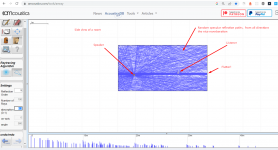

Some more example, some boundaries removed to better see where it might be good to places to put some absorbers to address early reflections, and flutter echo:
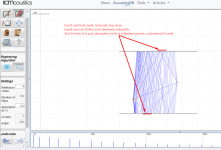
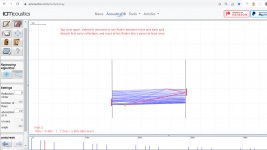
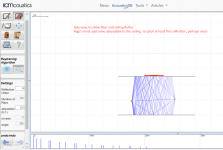
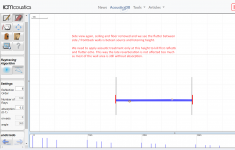
edit.
here is one more image, all 9 early reflections the simulator can show come within first 100ms so yeah not much late reverberation as its all pretty early
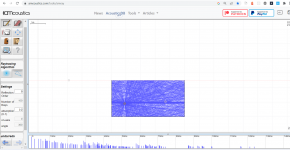

Practical guide from the above:
If one considers sidewall reflections good, then perhaps use some absorption on front / back walls in strategic positions. If rug is not enough for vertical reflections consider some panels on the ceiling. Now you'd have reduced flutter echo without touching any useful reverberation there is, the RTx0 values.
This is practical to me, perhaps not for all though I don't have dedicated listening room so haven't gone into studio construction stuff. All this is what seems feasible and practical to me, also minimal, for a family living room. One panel behind each speaker, perhaps few to back wall, perhaps few on the ceiling. Lower speaker height between furniture and perhaps no acoustic panels is required. Few subs also on plans to address notch around 30Hz.
I don't have dedicated listening room so haven't gone into studio construction stuff. All this is what seems feasible and practical to me, also minimal, for a family living room. One panel behind each speaker, perhaps few to back wall, perhaps few on the ceiling. Lower speaker height between furniture and perhaps no acoustic panels is required. Few subs also on plans to address notch around 30Hz.
If someone needs further material about flutter echo and how to perhaps address it, here goes:
Some kind of visualization to distinguish reflections that arrive to listening position from all directions at various intervals, this is what we want, the useful reverberation, spaciousness and all that. And then there is the flutter, multiple reflections between parallel boundaries that kills intelligibility for example. This happens portion of the boundaries that is between source and listener. One source available but anyone can adapt the idea to a multiple source situation.


Some more example, some boundaries removed to better see where it might be good to places to put some absorbers to address early reflections, and flutter echo:




edit.
here is one more image, all 9 early reflections the simulator can show come within first 100ms so yeah not much late reverberation as its all pretty early


Practical guide from the above:
If one considers sidewall reflections good, then perhaps use some absorption on front / back walls in strategic positions. If rug is not enough for vertical reflections consider some panels on the ceiling. Now you'd have reduced flutter echo without touching any useful reverberation there is, the RTx0 values.
This is practical to me, perhaps not for all though
Last edited:
i think so too, please read the section "reflection control" at this webpage https://www.acousticsciences.com/basic-concepts-for-listening-rooms/But that would kill the late reverberation, too dead of a room from the opening post, wouldn't it? I think this is the exactly wrong way to do it
this sounds, at least to me, to be the way to do it. must be very nitpicking at where to absorb and where to reflect, like for the side wall treatment, treatment devices must have different functions depending how and where soundwaves hits the device
"Once the early reflections have been erased, the listening ear hears a vacuum space, a black hole in the listening room. This is also not agreeable and so two sections of the back wall, one for each speaker, is kept flat and clear from any absorption or diffusion. This section acts like a mirror which beams sound back up along the side walls. On the side walls are sound absorbers/diffusers. They absorb sound coming at them from the speaker but side scatter reflections coming off the reflecting panel zones at the back of the room."
"Once the early reflections have been erased, the listening ear hears a vacuum space, a black hole in the listening room.
This doesn't happen. It's only the FIRST reflections, in small rooms there are plenty of other, strong reflectins and you never loose the feeling for the size of the room with such a basic treatment. I realised a "non environment room" with 4 completely absorbing surfaces (which is way to much for living room listening) and you still have the acoustical feeling of a small room when you move through the room (but not when at the listening position - that's the whole point).
Early reflections are also NO HIGH FREQUENCY ONLY thing - they are broadband, produce comb filtering at lower frequencies and need to be addressed with broadband absorption!
And even if there are some missconseptions in your link they still do corner trapping first and the go for early reflections - exactly what I would suggest, just do it right in the first place
When your room is long enough you can use diffusion at the rear end but you must know how this stuff works. You need distance to diffusers, otherwise you hear comb filtering. And diffusers are strongly frequency dependend - so they diffuse just a part of the audio spectrum.

This is a measurement of a very good diffuser - and you still see it's not working as good between 1kHz and 4kHz - which seems typical for skyline diffusers and is exactly the frequency range where you would NEED diffusion. I only use a curved "diffuser" in my recording room which helps against flutter and is broadband but is a very simple way of "scattering" (in fact debateable if you count it as diffuser) and also needs some distance of listening or audio sources.
And the better your room get's controlled the more annoying is flutter cause it doesn't get masked by all the other reflections any more. As it's a living room you probably move around freely ;-) so this can happen at any place in your room. A good example are high rooms which are only treated up to 2m - sound bounces happily around up there and comes back after a quite long time, very annoying (I tested this in one of my first flats very long ago ;-))
The problem in YOUR room is you have not enough broad band absorption and way to much high frequency absorption! Your room get's dull and is still boomy and reverb/reflection in the 100-300Hz area destroys clarity/muddens stuff. It's unbalanced, what you notice when you move your head.
Follow the "simple" rules first and then post a scetch and a few photos and we can help with fine tuning.
This doesn't happen. It's only the FIRST reflections, in small rooms there are plenty of other, strong reflectins and you never loose the feeling for the size of the room with such a basic treatment. I realised a "non environment room" with 4 completely absorbing surfaces (which is way to much for living room listening) and you still have the acoustical feeling of a small room when you move through the room (but not when at the listening position - that's the whole point).
Early reflections are also NO HIGH FREQUENCY ONLY thing - they are broadband, produce comb filtering at lower frequencies and need to be addressed with broadband absorption!
And even if there are some missconseptions in your link they still do corner trapping first and the go for early reflections - exactly what I would suggest, just do it right in the first place
When your room is long enough you can use diffusion at the rear end but you must know how this stuff works. You need distance to diffusers, otherwise you hear comb filtering. And diffusers are strongly frequency dependend - so they diffuse just a part of the audio spectrum.
This is a measurement of a very good diffuser - and you still see it's not working as good between 1kHz and 4kHz - which seems typical for skyline diffusers and is exactly the frequency range where you would NEED diffusion. I only use a curved "diffuser" in my recording room which helps against flutter and is broadband but is a very simple way of "scattering" (in fact debateable if you count it as diffuser) and also needs some distance of listening or audio sources.
And the better your room get's controlled the more annoying is flutter cause it doesn't get masked by all the other reflections any more. As it's a living room you probably move around freely ;-) so this can happen at any place in your room. A good example are high rooms which are only treated up to 2m - sound bounces happily around up there and comes back after a quite long time, very annoying (I tested this in one of my first flats very long ago ;-))
The problem in YOUR room is you have not enough broad band absorption and way to much high frequency absorption! Your room get's dull and is still boomy and reverb/reflection in the 100-300Hz area destroys clarity/muddens stuff. It's unbalanced, what you notice when you move your head.
Follow the "simple" rules first and then post a scetch and a few photos and we can help with fine tuning.
thank you, i take the opportunity to get some professional advice here. this is my current room, long walls are of concrete and short walls are of bricks.post a scetch and a few photos and we can help with fine tuning.
i started with the speakers placed along the long wall and there where just to much bass, with the listening position closer to the middle of the room the sound where more in balance but still to much bass. i then added corner traps in the room, those yellow things in the scetch below. still some bass frequencies where to prominent.
then i changed the orientation of the hole setup so the speakers now where placed along the short wall, this setup turned up to be very bass shy, i had to push speakers and listening chair very close together either in front of the room or in the back or the room to get a balanced tonality, but this got me a very dark or dead sounding back end which where very annoying - i put some reflectors behind me to get at least some ambience or lightness or airyness to the play back sound.
to get a larger speakers-to-listening-position-distance i also tried a sub setup which quickly turned into a multiple subs setup like in the 4th setup below, this got me a amazingly even bass response. but it was still not perfect, it sounded a bit "phasey", i could not find what it was, but the complicated setup just and the phasey sound just drove me crazy so turned back to the 2nd setup which where i am today. one thing i regret that i did not tried with the multiple subs where to have them placed close to the ceiling, i think that would have make the path lenght differencies between the subs smaller.
what i woud like to test for next is trying out a equalizer for bass contour and have diffusors on the back wall for more airyness, but any other suggestion or solution are very welcomed
- Home
- General Interest
- Room Acoustics & Mods
- simple rules for good listening room acoustics?